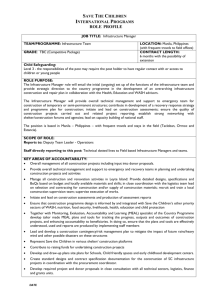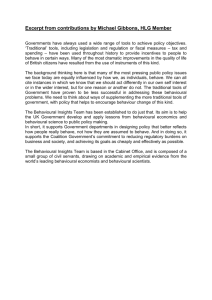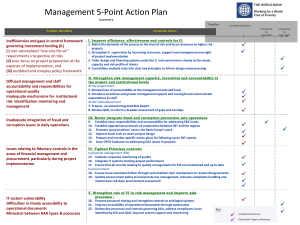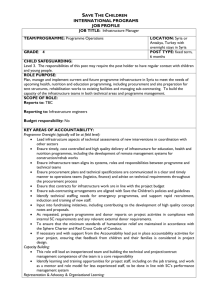Behavioral Logistics and Productivity
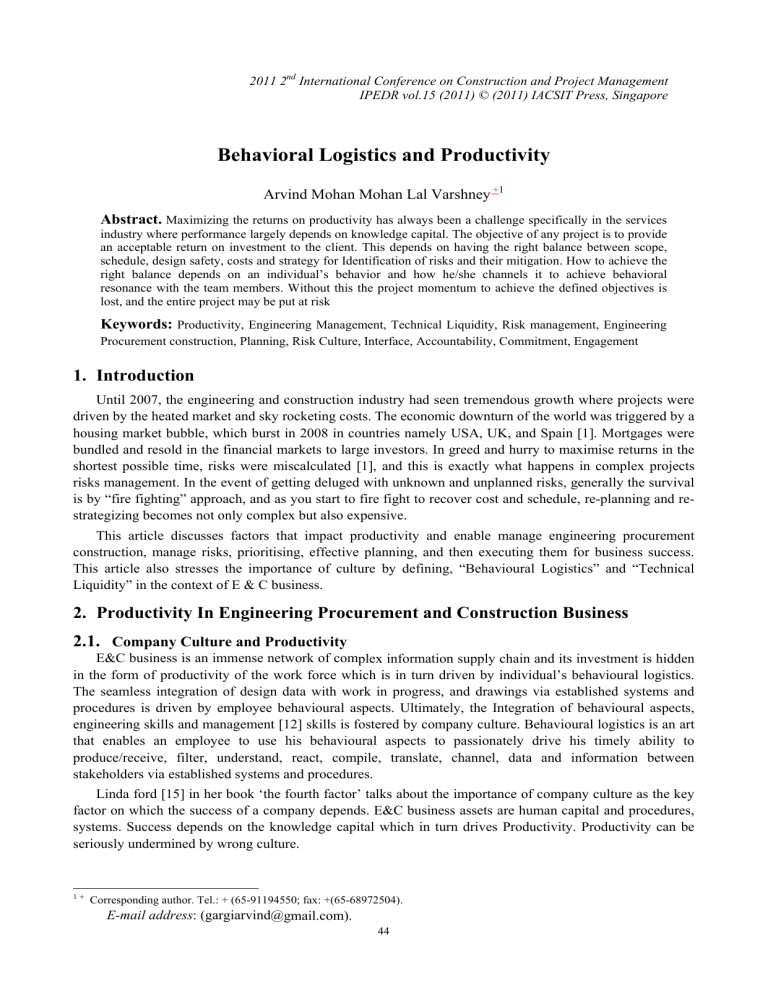
2011 2 nd
International Conference on Construction and Project Management
IPEDR vol.15 (2011) © (2011) IACSIT Press, Singapore
Behavioral Logistics and Productivity
Arvind Mohan Mohan Lal Varshney
+ 1
Abstract.
Maximizing the returns on productivity has always been a challenge specifically in the services industry where performance largely depends on knowledge capital. The objective of any project is to provide an acceptable return on investment to the client. This depends on having the right balance between scope, schedule, design safety, costs and strategy for Identification of risks and their mitigation. How to achieve the right balance depends on an individual’s behavior and how he/she channels it to achieve behavioral resonance with the team members. Without this the project momentum to achieve the defined objectives is lost, and the entire project may be put at risk
Keywords:
Productivity, Engineering Management, Technical Liquidity, Risk management, Engineering
Procurement construction, Planning, Risk Culture, Interface, Accountability, Commitment, Engagement
1.
Introduction
Until 2007, the engineering and construction industry had seen tremendous growth where projects were driven by the heated market and sky rocketing costs. The economic downturn of the world was triggered by a housing market bubble, which burst in 2008 in countries namely USA, UK, and Spain [1]. Mortgages were bundled and resold in the financial markets to large investors. In greed and hurry to maximise returns in the shortest possible time, risks were miscalculated [1], and this is exactly what happens in complex projects risks management. In the event of getting deluged with unknown and unplanned risks, generally the survival is by “fire fighting” approach, and as you start to fire fight to recover cost and schedule, re-planning and restrategizing becomes not only complex but also expensive.
This article discusses factors that impact productivity and enable manage engineering procurement construction, manage risks, prioritising, effective planning, and then executing them for business success.
This article also stresses the importance of culture by defining, “Behavioural Logistics” and “Technical
Liquidity” in the context of E & C business.
2.
Productivity In Engineering Procurement and Construction Business
2.1.
Company Culture and Productivity
E&C business is an immense network of complex information supply chain and its investment is hidden in the form of productivity of the work force which is in turn driven by individual’s behavioural logistics.
The seamless integration of design data with work in progress, and drawings via established systems and procedures is driven by employee behavioural aspects. Ultimately, the Integration of behavioural aspects, engineering skills and management [12] skills is fostered by company culture. Behavioural logistics is an art that enables an employee to use his behavioural aspects to passionately drive his timely ability to produce/receive, filter, understand, react, compile, translate, channel, data and information between stakeholders via established systems and procedures.
Linda ford [15] in her book ‘the fourth factor’ talks about the importance of company culture as the key factor on which the success of a company depends. E&C business assets are human capital and procedures, systems. Success depends on the knowledge capital which in turn drives Productivity. Productivity can be seriously undermined by wrong culture.
1 + Corresponding author. Tel.: + (65-91194550; fax: +(65-68972504).
E-mail address
: (gargiarvind@gmail.com).
44
Hence the link between culture and productivity is important. According to Michael Porter “There is no possibility of achieving competitiveness without raising the culture of productivity,” Productivity is not just about the amount of work produced in a given time but also the whole engagement process within the company and with client which brings out the flavour of the quick decision making process. Company culture drives personnel to respond to any questions immediately with integrity and passion. Visible
Leadership of Discipline leads assures clients that designers and engineers are being supervised to deliver quality and safe design. This drives confidence in client and also fosters trust with the E&C contractor.
Laurence Prusak [14] says that “humans can build the social processes to facilitate knowledge exchanges between people -- experts and novices, and even more importantly, build a culture that values shared learning”. Knowledge is applied to interpret information and then to take appropriate action. Timely and appropriate use of knowledge [2] and information depends on behavioural aspects.
2.2.
Risk Culture and Impact on Productivity
In E P& C business each discipline and individual engineer are heavily interdependent. Any systemic failure in that network can, very rapidly [7] bring the system to a halt exposing the vulnerability about the timely and systemic availability of information.. This is one of the key causes that impact productivity.
Risks by definition are not evident and need to be identified. In essence, E & C companies offer their people expertise, soft and hard skills and knowledge to manage client’s risks. Ultimately, the extreme importance of having the “right human capital” cannot be ignored. “Right human capital” here means a professional person with accountability and commitment that in turn has the ability to keep the team engaged continuously with an extra effort towards co-ordination between individuals. In the E&C value chain, the managers/discipline lead’s knowledge about the business environment may get biased by earlier projects successes if the lessons learnt are not in the memory or system data bank. Manager’s or lead’s decision making may be influenced by how he/she approaches a risk. Hence identification of Risks and their mitigation is heavily dependent on managerial decision making process [11]. An initial in depth scenario analysis, careful negotiation and documentation of the relevant agreements with client, contractors, and all disciplines together with support from sponsors [9] ensures that risks are allocated to the right party.
Interfaces are key areas having potential risk and Engineering and construction being one of them determines project success if managed from start. Key details on deliverables including cross referencing of precursor and successor scope help, the construction planner to schedule activities and plan resources correctly. Aligned deliverables and activities, capture and communicate correct scope, milestones, issues, which in turn result in proper planning for adequate skills or capabilities, promising possible delivery dates, and accurate status reports. This saves time. Hence you avoid (a) justifying your design and convincing client to accept what has been produced (b) re-submitting design options and re-designing (c) updating procedures, specifications, and standards to make the deliverable match the client’s requirement. Consultant and client need to (a) understand the cost of alignment and decision making and, (b) agree on what content is required to make the deliverables complete, and when in the project should they be complete to minimise risk [8]. Project Deliverables defined in detail ensure that the information is on target and provides value, and ensures that team members have clear concrete goals for small incremental project progress
Lessons learnt have huge potential to avoid risks. Risks are probably there all along in all projects. It is just that we may get biased while identifying or ranking the risks [7]. In accordance to the global and project scenario, our perception of risks and uncertainties could change during the course of project execution.
During the project life cycle, changes or ongoing modifications could risk Design safety, relationships, cost and schedule if not managed properly. Despite project complexities changes and claims could be reduced if not totally avoided if you have quality resource, properly defined contract strategies, good planning, robust project execution plan, focus on early identification of risks, resource-driven schedule, subcontract planning, good understanding of the management of change, complete project documents, clear and transparent policies and procedures.
Capability to understand and execute in accordance to scope, Technical competence, accountability, ownership and commitment, is the perfect combination for success. Each one of this is a key ingredient to develop behavioural aspect and hence manage risk, and ultimately cost and schedule.
45
2.3.
Productivity In Procurement and Engineering Interface
Quality and timely Supplier information can boost productivity in the design process while Behavioural phenomenon like “Parkinson’s Law” and “student’s syndrome” can kill productivity. Procurement links engineering and construction. Materials and their technical information lay the foundation of success in construction. Project uncertainty is unique for various projects. A new site condition, a new client in a different country, same client and or same contractor with different people, repeat project with same client and contractor team but different budget, or new suppliers can all lead to new project uncertainties and requirements. Fast track projects have severely high overlaps of engineering/ design phase with the procurement and construction phase, which further add to complexities and uncertainties. Such complexities and uncertainties of procurement may affect the entire engineering and construction process and overall project schedule, budget [17].
The procurement market is becoming increasingly complex, with new technology in both fabrication/production, logistics. Team which thinks strategically to quickly turn around information required for design greatly decreases the number of surprises that could crop up later in the project. This enables exchange of valued information instead of frustrations being passed from procurement to engineering and vice versa. The planning process should cover specific plans to monitor the performance of suppliers [10].
Culture of partnerships need to be developed.
2.4.
Prerequisites for Maximizing Productivity In E P &C Business
Analyzing productivity levels in the E&C business and implementing corrective ways is unique to each
E&C contractor. Client power, fast track projects, and new concepts in contracting strategies influence the process of optimizing and or maximizing productivity. The shift to concurrent design, procurement and construction necessitates the need to integrate the work activities of each phase.
Behavioural aspects of ACCOUNTABILITY, COMITTMENT AND ENGAGEMENT are key prerequisites to maximize productivity, and to overcome any sort of inertia and resistance that may make the risk management and information exchange process opaque instead of transparent. A well-led, accountable, committed and engaged workforce delivers quality services to clients and a strong return to shareholders.
Arie de Geus [16], in his book, “The Living Company”, introduces the concept of a Living Company vs. an
Economic Company and talks about concepts that allows us to focus on the most difficult areas to increase productivity.
2.4.1.
Commitment and Accountability
Continual assessment and improvement of the systems and procedures ensures that known activities are more predictable and the unknown can be managed easily. Continuous cross-functional discussions ensure that disparities and gaps between disciplines are uncovered and bridged. Donald Sull of the London Business
School (Managing by commitment) views an organisation as a network of overlapping, continually evolving promises that people make to each other to get things done. E, P&C companies operate in a vast network of
“task force” people who do not report to each other directly, like, third party inspectors, suppliers, subsuppliers, government agencies, various engineering disciplines, clients project team, clients operations stakeholders, subcontractors, where managing commitment is key to the success of engineering communication.
Commitments might fail when people start cutting/bypassing the constraints when under pressure to meet fast track schedules [18]. In further efforts to shorten/optimize the schedule constraints may be either further cut or their impacts not realized. Eventually, managers and leads could go beyond their ability to understand and manage the risks resulting from their decisions. Accountability can overcome the possibility of an erratic flow of work, deign errors, rework, a deterioration of detailed planning, and gross schedule overruns [18].
Accountability means that an individual has a clear insight into what initiatives are required to succeed by a specific date. When problems come up despite planning for prevention and avoidance, “Accountability and commitment” are the best strategies to identify and resolve them, without which the project could fail.
Just as one bank’s failure led to an interconnected world-wide economic failure, success is inextricably
46
linked. Instead of accepting tense relationships, rivalries, and factions it is always a better option to remain connected, committed to each other’s goals so that the team and not an individual wins.
What do you do when you have too many commitments to fulfil? Managing and agreeing on Priority follows closely in such a scenario. If you are not sure about the real goals then there could be much re-works caused by shifting priorities and unexpected (“requirements”) requests, changes such that the engineers and designers tend to lose focus. Priority is a preferential rating which if not defined and agreed can be a
“cumulative risk in process”, which, is unlike manufacturing industries where once the production line starts there is no “risk in process”.
2.4.2.
Engagement
ISR, a leading employee research firm, found that companies with higher engagement have 5.75% better operating margins than those less engaged [6]. The New York Conference Board defines employee engagement as: a heightened emotional and intellectual connection that an employee has for his or her job, organisation, manager, or co-workers that, in turn, influences him or her to apply additional discretionary effort to his or her work. Engaged employee demonstrates ownership, is highly passionate, motivated and productive. He always goes for that “extra mile” effort, and will continuously look for improvement. People want to feel engaged, so help make that happen. Commitment requires personal investment and buy in which is unlikely if you are more of an observer [13]. A well engaged team responds faster and better in urgent situations of unexpected demands.
Resource Globalization sees project members coming from different horizons with their own culture and task force are formed quickly, which further stresses the need for engagement. The formula is “Engage to delegate and get performance”. Lead by example to get a focussed and dedicated team. .
Planning is best if done by people who understand team behaviour, attitude, culture and productivity.
There could be instances where someone is either ahead or lagging as per plan and in many cases the reasons are (a) productivity (b) skills to manage relations (c) skills in managing information (d) behaviour. In such cases we have an obligation to interfere with the upstream and downstream users to alert them so that the value chain is aligned. Without engagement, it may not be possible for leads or managers to understand the productivity, capacity of their team resulting which the team could operate beyond the framework of company’s systems and procedures.
It is natural that balance is important for life. Likewise, to achieve maximum performance the correct mix of stress, reward and passion is required from the employee [13]. The lead’s or manager’s message will get attention if (a) the message is personalized (b) it evokes an emotional response (c) it comes from a trustworthy or respected person (d) if the message is concise [13]. To assume that all engineers are trained managers-professional and hence need not be engaged could be the start of problems. This could be due to the superior’s lack of skills or an excuse to avoid taking ownership of their team’s output. In an engaged team not only the lead but also his team is aware of the scope, schedule, and costs. Professionalism is demonstrated, delivered, lived up to and expected. There is no blame and chaos. . Responsibility and moral integrity are the key elements in a professional. An Engaged Professional [20] employee works selflessly in the interest of project. Sustained attention in work is important and is similar to making a promise and keeping it. It is far more important to do the latter. The intensity and level of engagement must be such that an employee who does not want to heed the message would have a tough time avoiding it [13].
2.5.
Conclusion
A positive and competitive spirit can easily die without the right culture. The “right human capital” that has the capability to juggle between the technical and managerial role is important in providing a cushion for the E & C companies in times of “roller coaster” situations. Managing culture to maximize productivity and company destiny [15] is crucial. “Accountability, Commitment and Engagement” are the building blocks of behavioural logistics that drive productivity. “Technical Liquidity” is a good parameter to gauge the company success. Technical liquidity means, a strong company culture driven by behavioural logistics that fosters productive use of its highly competent resources, robust systems, procedures and infrastructure which enable to bring you back on track in testing situations minimizing schedule impact.
47
3.
Acknowledgements
I wish to thank my Wife, Gargi and my Son Anubhav who supported me and are my source of inspiration in writing this article.
4.
References
[1] GLOBAL INTELLIGENCE ALLIANCE, GLOBAL INTELLIGENCE ALLIANCE (2009JAN). MARKET
INTELLIGENCE. MARKET INTELLIGENCE,
[2] THOMAS H. DAVENPORT, LAURENCE PRUSAK. (WORKING KNOWLEDGE—HOW ORGANIZATIONS
MANAGE WHAT THEY KNOW 1998).
[3] GLOBALBRAIN INC, (2009). HOW AN IT TEAM BROKE FREE FROM THE REQUIREMENTS MORASS.
RETRIEVED MARCH 20, 2009, HTTP://WWW.PROJECTCONNECTIONS.COM/
[4] GORDON PITTS, (2009, MARCH 16). PEGGY CUNNINGHAM: BREAKING THE MONSTER MOULD.
RETRIEVED MARCH 20, 2009, HTTP://BUSINESS.THEGLOBEANDMAIL.COM
[5] JEREMY DANN, (2009, MARCH 4TH). DONALD SULL: MANAGE BY COMMITMENTS, NOT
HIERARCHIES. RETRIEVED MARCH 20, 2009, HTTP://BLOGS.BNET.COM/MBA/?P=419
[6] SUCCESS FACTORS, (2009). ROADMAP TO SUCCESS:DRIVING BOTTOM-LINE RESULTS WITH
PEOPLE PERFORMANCE. ROADMAP TO SUCCESS:DRIVING BOTTOM-LINE RESULTS WITH PEOPLE
PERFORMANCE, RETRIEVED 2009, FROM HTTP://WWW.SUCCESSFACTORS.COM
[7] MCKINSEY, (2009). A FRESH LOOK AT STRATEGY UNDER UNCERTAINTY: AN INTERVIEW .
RETRIEVED MARCH 20, 2009, WEB SITE:
HTTP://WWW.MCKINSEYQUARTERLY.COM/STRATEGY/STRATEGIC_THINKING/FRESH_LOOK_AT_
STRATEGY_UNDER_UNCERTAINTY_2256?GP=1
[8] GETTING ALIGNED AND STAYING IN SYNC FOR SUCCESSFUL PROJECTS WITH OUTSIDE
PARTNERS AND OTHER VIRTUAL TEAM MEMBERS CINDA VOEGTLI, FOUNDER,
PROJECTCONNECTIONS.COM
[9] WORLDS APART: EPC AND EPCM CONTRACTS: RISK ISSUES AND ALLOCATION. BY PHIL LOOTS
AND NICK HENCHIE
[10] RENÉE DYE, OLIVIER SIBONY, AND S. PATRICK VIGUERIE, RENÉE DYE, OLIVIER SIBONY, AND S.
PATRICK VIGUERIE (2009). STRATEGIC PLANNING: THREE TIPS FOR 2009. STRATEGIC PLANNING:
THREE TIPS FOR 2009 , FROM
HTTP://WWW.MCKINSEYQUARTERLY.COM/STRATEGIC_PLANNING_THREE_TIPS_FOR_2009_2340
[11] PROJECT PERSPECTIVES. THE ANNUAL PUBLICATION OF INTERNATIONAL PROJECT
MANAGEMENT ASSOCIATION 2009. VOL. XXXI. ISSN 1455-4178
[12] K SINGH, S, C KUNDU, SUBHAS, & SINGH, SHOBA. (1998). Logistics management [VOLUME 8]. (HTML),
[13] GETTING THE ATTENTION YOU NEED.-THOMAS H DAVENPORT AND JOHN C BECK—HARVARD
BUSINESS REVIEW.
[14] LARRY PRUSAK. RESEARCHER AND CONSULTANT.. FOUNDER AND EXECUTIVE DIRECTOR OF
THE INSTITUTE FOR KNOWLEDGE MANAGEMENT (IKM).
[15] LINDA FORD—“THE FOURTH FACTOR”
[16] THE LIVING COMPANY: HABITS FOR SURVIVAL IN A TURBULENT BUSINESSENVIRONMENT,--
ARIE DE GEUS.
[17] INTEGRATING SUPPLY CHAIN AND CRITICAL CHAIN CONCEPTS IN ENGINEER-PROCURE-
CONSTRUCT (EPC) PROJECTS. K.T. YEO*, J.H. NING
[18] LEAN CONSTRUCTION AND EPC PERFORMANCE IMPROVEMENT. GLENN BALLARD
[19] PRODUCTIVITY IMPROVEMENT IN DOWNSTREAM EPC PROJECTS USING VALUE STREAMS
BASED ORGANIZATION. KRISHNAN RAGHUNATHAN. MIT. JUNE 2006.
[20] WHO IS A PROFESSIONAL- HELEN G HURD-1967
48
